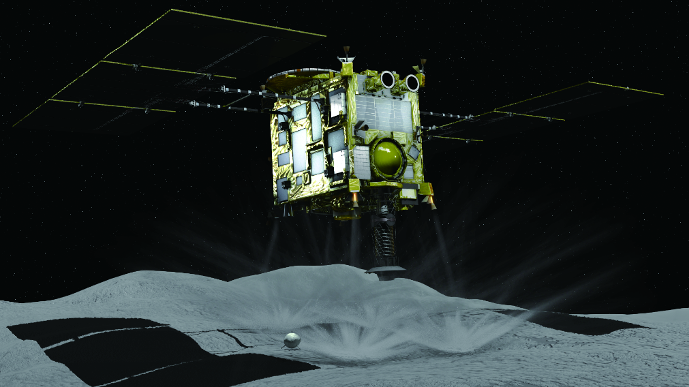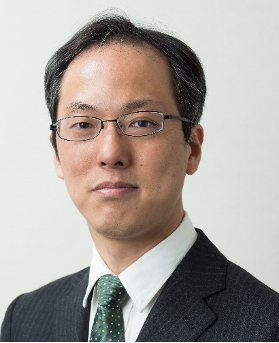Hayabusa2 – Surveys and Samples from Asteroid Ryugu and Beyond
Technologies and Challenges for a Round-Trip Journey to an Unexplored Small Body
Yuichi Tsuda
Project Manager, Hayabusa2 Project
Institute of Space and Astronautical Science
Japan Aerospace Exploration Agency
Sponsored by a PSW Science Member who has asked to remain anonymous
About the Lecture

Hayabusa2 is an asteroid exploration probe, developed and launched by the Japan Aerospace Exploration Agency (JAXA), which visited a carbonaceous (C-type) asteroid Ryugu in 2018-2019, and returned to Earth in December 2020.
Although the mission faced many hardships due to the unexpectedly severe environment of Ryugu, it finally succeeded in landing and collecting samples from two different locations on the asteroid surface, delivering four mobile robots to the asteroid surface for surface exploration, and generating a very large artificial crater for the impact science and subsurface investigation. In addition, Hayabusa2 brought back to earth 5.4g of Ryugu samples, which are being analyzed by researchers in institutes all over the world, bringing many surprising discoveries. And, after separating the sample return capsule toward Earth, the Hayabusa2 spacecraft continued its flight toward two new asteroids on an extended mission that will produce additional science results.
The talk will cover the mission process, hardships, scientific achievements and the plans for the on-going mission. It will show how scientifically powerful the sample return mission has been and how fruitful such sample return missions can be from both the engineering and the scientific perspectives.
Reading & Media References
(1) Hayabusa2 / Hayabusa2 Extended Mission Project Website https://www.hayabusa2.jaxa.jp/en/
(2) Hirabayashi M. and Tsuda Y. (Eds.) (2022): Hayabusa2 Asteroid Sample Return Mission, Technological Innovations and Advances, ELSEVIER [ISBN: 0323997317
ISBN13: 9780323997317]
About the Speaker

Yuichi Tsuda is currently the team leader of the Hayabusa2 Extended Mission and Professor in the Institute of Space and Astronautical Science at the Japan Aerospace Exploration Agency and in the Department of Aeronautics and Astronautics in the Graduate School of Engineering of the University of Tokyo.
He joined the Institute of Space and Astronautical Science in 2003 and has served there first as a research associate, then Associate Professor and now as Professor. He also has been a visiting scholar in the Department of Aerospace Engineering at the University of Michigan and as well in the Department of Aerospace Engineering Sciences at the University of Colorado-Boulder.
His research interests include astrodynamics, spacecraft systems, and deep space exploration. He led the development and operation of the Hayabusa2 mission, which successfully brought a significant amount of material from a carbon-rich asteroid for the first time in human history, serving as chief engineer from 2007 to 2015 and as project manager from 2015 to 2022. He also served as deputy lead of the IKAROS mission, the world’s first interplanetary solar sail mission in 2009-2013.
Among other honors and awards, Yuichi’s team received the IAA Laures award in 2017, the Aviation Week Laureate Award in 2019, the Japan Prime Minister’s Commendation in 2020, the IAF World Space Award in 2021.
Yuichi earned his undergraduate and graduate degrees, including his PhD, at the University of Tokyo in Aeronautics and Astronautics.
Minutes
On September 22, 2023, in the Powell Auditorium of the Cosmos Club in Washington, D.C, and by live stream on the PSW Science YouTube channel, President Larry Millstein called the 2,481st meeting of the Society to order at 8:02 p.m. ET. He began by welcoming attendees, thanking sponsors for their support and announcing new members. Mark Clampin then read the minutes of the previous meeting and the lecture by Tabitha Dodson on the DRACO project lecture, prepared by recording secretary Cameo Lance. There being no comments on the minutes they were approved as read.
President Millstein then introduced the speaker for the evening, Yuichi Tsuda, Project Manager for the Hayabusa2 Project of the Japan Aerospace Exploration Agency. His lecture was titled, “Hayabusa2 - Surveys and Samples from Asteroid Ryugu and Beyond.”
Tsuda began by thanking the society and saying he was honored to speak. He said that his lecture would cover the story of the Hayabusa2 asteroid return mission and its significant outcome. He noted that, as a guidance, navigation, and control engineer, the engineering aspects of the mission excite him the most; but, he said he would talk about the scientific results as well.
To begin the lecture he played the video recording of the second successful touchdown of Hayabusa2 on asteroid Ryugu. He emphasized that there were two touchdowns performed by the one space craft. He then placed the mission in the context of JAXA’s overall space exploration efforts, giving an overview of JAXA’s missions to the moon, planets, and small bodies within the solar system.
He then reviewed the timeline, key features, and scientific objectives of the Hayabusa2 mission. He noted that the spacecraft was the world’s second sample return mission to a small body and that the round trip took over six years. The primary scientific objective is to gather samples that will help us to understand the history of the solar system, he said, and potentially, provide clues to the origin of life.
He then detailed the timeline and the specific maneuvers that the spacecraft had to undergo to reach Ryugu, collect samples and return them to earth. He discussed the spacecraft's instrumentalities and its instrumentation. He noted that Hyabusa2 had twelve deployable components, including a reentry capsule, a rover, a lander, and a small impactor.
The speaker then discussed findings of the mission. He said that Hayabusa2 found that Ryugu is a rocky-top shaped asteroid with a bumpy surface and a rotational period of just under eight days. He noted that the rocky surface made it hard for the engineers to identify a good touchdown site. He showed pictures of a variety of models they made of the surface to help them locate the best places to land and obtain samples. And he showed a video of the lander being directed to the landing zone, explaining that it employed autonomous tracking systems, and noting that the spacecraft was too far from earth for real-time control from the ground. The audience applauded when the video showed successful touch down.
He mentioned that the origin of the name Ryugu is in an ancient Japanese fairy tale, and that the team named geological features on Ryugu after additional fairy tales from around the world. He also noted that the pandemic caused difficulties for the 2020 return of the sample capsule to Earth; but, that these were overcome.
He then showed an inspiring video of the team’s activities in Australia to locate the sample capsule after it returned to earth and transport it safely back to Japan. He discussed the initial analysis of the samples, pointing out that they found water and organic molecules, including amino acids. He noted that the amino acids found in the Ryugu samples were equally left- and right- handed, whereas those in living organisms on earth are always left-handed. He noted that the sample catalog has been opened to the public and that samples are being shared for further analysis.
The speaker concluded the lecture with some remarks about NASA's OSIRIS-REx, which was scheduled to land just days after the lecture. He noted that he had had to stay in Japan for the return of the Ryugu sample capsule, as head of the headquarters team. So, he was particularly excited to be traveling to Utah the next day at the invitation of NASA to be with the team that would be recovering the OSIRIS-REx capsule when it returned to earth.
After the lecture was done there was a question and answer period.
A live-stream viewer in Sweden asked whether there was any crowd sourcing considered for the mission, like there was with ORIRIS-REx, through which people assisted with mapping the surface of Bennu. The speaker answered that OSIRIS-REx had a larger camera which changed the engineering challenges. The Hyabusa2 mission did not use crowd sourcing, but instead frequently flew close to the surface frequently to take higher resolution images in which to navigate from.
Another member noted that there was a film made about the Hyabusa1 mission and asked whether there will be one about the Hyabusa2 mission. The speaker said that Hyabusa1 was in three films, and that that mission was beset with dramatic engineering troubles and dramas. Hyabusa2, he said, did not have such problems and although it was filled with scientific challenges these apparently are less exciting to the public. Thus far, he said, there have been no offers to make a movie about Hayabusa2.
Another member asked if the Hayabusa2 team used stereoscopic imaging to help understand the surface topology, as was done for OSIRIS-REx and Bennu, and if so was Brian May involved. The speaker said they had not used stereoscopic imaging to map the surface but that they worked with May and used that approach for other purposes.
After the question and answer period, President Millstein thanked the speaker and presented him with a PSW ribbon and with signed copies of the announcement of his talk and of Volume 1 of the PSW Bulletin. He then announced the speakers of the up-coming lectures, made a number of housekeeping announcements, and invited guests to join the Society. After that the meeting was then adjourned. The time was 9:56 pm ET.
Temperature in Washington, DC: 19° C
Weather: Slight Drizzle
Audience: 53 in person and 32 on the live stream, for a total of 85
Views of the video in the first two weeks: 309
Respectfully submitted,
Janice Soreth
On behalf of Recording Secretary Cameo Lance